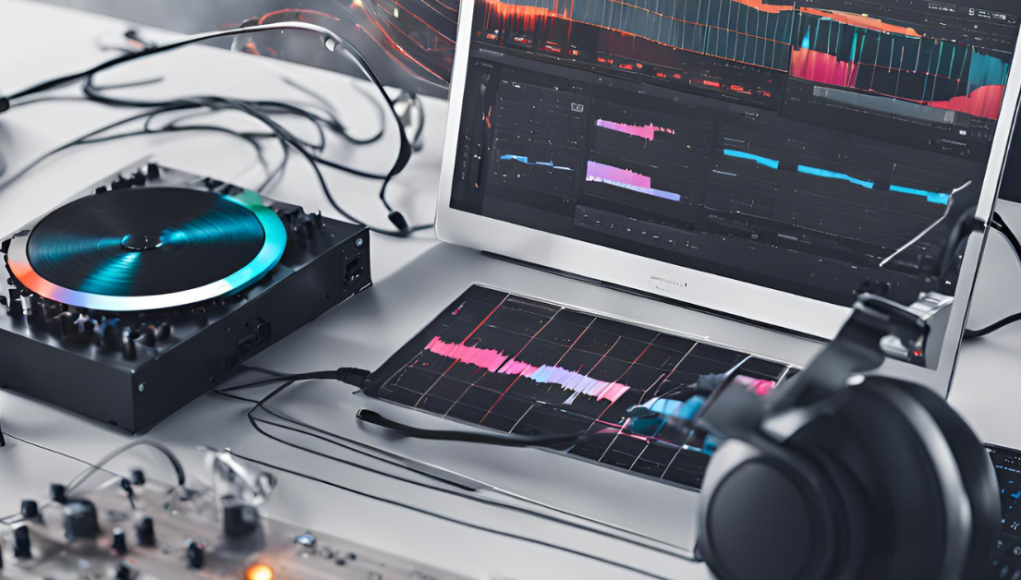In today’s digital age, music production has become more accessible than ever, thanks in large part to advancements in artificial intelligence (AI). Among these advancements, AI tools for music remixing have emerged as a significant innovation, allowing both seasoned musicians and beginners to reimagine tracks with minimal effort. This article will explore the top AI tools for music remixing, but first, let’s delve into the fundamentals of audio mixing, how AI enhances this process, and why it is crucial in music production.
What is Audio Mixing?
Audio mixing is the process of blending individual tracks together to create a final version of a song. This involves adjusting levels, equalizing frequencies, adding effects, and ensuring that each element of the track complements the others harmoniously. Traditionally, audio mixing is done manually by sound engineers who meticulously balance every aspect of the music to achieve the desired sound. However, with the rise of AI, much of this process can now be automated, making it more accessible to a wider audience.
Why is Audio Mixing Required?
Audio mixing is essential for several reasons:
– Enhances Clarity: Proper mixing ensures that all elements of the track are clear and audible, without any component overshadowing the others.
– Creates Depth and Dimension: Through techniques such as panning and reverb, mixing adds depth, making the music sound more dynamic and engaging.
– Ensures Consistency: Mixing ensures that tracks are consistent in terms of volume, tone, and effects, which is particularly important for albums and playlists.
– Polishes the Final Product: Good mixing can turn a raw recording into a polished, professional-sounding track, ready for distribution.
Who Needs Audio Mixing?
– Musicians and Bands: To ensure their music sounds professional and polished before release.
– DJs: To create seamless transitions and remixes for live performances or recordings.
– Podcasters: To blend voice recordings, music, and effects for a coherent final product.
– Content Creators: To enhance the audio quality of videos, streams, and other digital media.
The Evolution of AI in Music Production
Artificial intelligence has significantly transformed the landscape of music production. Initially, AI was primarily used for tasks like composing simple melodies or generating background music. However, as machine learning algorithms have become more sophisticated, AI’s role in music production has expanded to include complex tasks such as mixing and mastering. AI-driven tools are now capable of analyzing vast amounts of musical data, learning from it, and applying that knowledge to create high-quality mixes. This evolution has made professional-grade music production accessible to a broader audience, including those without formal training in sound engineering.
How Does AI Mix Music?
AI in music mixing works by leveraging machine learning models that have been trained on thousands, or even millions, of professionally mixed tracks. Here’s how the process typically works:
– Audio Analysis:
AI begins by analyzing the raw audio tracks that make up a song. This includes identifying and isolating different elements such as vocals, drums, bass, and other instruments. The AI examines these elements in detail, recognizing patterns, frequencies, and the roles each component plays in the overall mix.
– Learning from Examples:
The AI uses its training data to understand what makes a mix sound balanced and professional. It has learned the typical frequency ranges, volume levels, and effects settings that are commonly used for different genres of music. For example, it knows that vocals usually sit in a certain frequency range and that bass should have a specific level of presence in the mix.
– Automated Adjustments:
Once the analysis is complete, the AI begins adjusting the audio tracks. It balances the volume levels so that no single element overpowers the others, applies EQ (equalization) to enhance the sound quality of each track, and adds effects like reverb or delay where necessary. These adjustments are made based on the genre and style of the music, as well as the specific preferences set by the user.
– User Input:
Despite the automation, AI mixing tools often allow users to customize the mix. Users can adjust parameters such as the loudness of the bass, the prominence of vocals, or the amount of reverb on a guitar track. The AI then refines the mix according to these inputs, ensuring that the final product aligns with the user’s creative vision.
Advantages of AI in Music Mixing
– Efficiency:
AI can mix tracks much faster than a human engineer, making it ideal for quick projects or when working with large volumes of music. What might take hours for a human to accomplish can often be done in minutes by AI.
– Accessibility:
Even those with little to no experience in music production can achieve professional-sounding mixes using AI tools. This democratization of music production allows more people to participate in the creative process without needing to invest in expensive equipment or years of training.
– Consistency:
AI ensures a consistent sound quality across multiple tracks, which is especially useful for albums or sets. By applying the same principles across all tracks, AI can help maintain a cohesive sound throughout an entire project.
– Creative Freedom:
AI handles the technical aspects of mixing, freeing up musicians and producers to focus on the creative side of music-making. Instead of worrying about the intricacies of sound engineering, artists can concentrate on crafting unique and compelling music.
Limitations of AI in Music Mixing
While AI has made significant strides, it is not without its limitations:
– Lack of Human Intuition:
AI lacks the human touch and intuition that experienced sound engineers bring to the table. It can struggle with understanding the artistic nuances that a human might easily perceive.
– Dependency on Input Data:
The effectiveness of AI mixing largely depends on the quality and diversity of its training data. If the AI is trained on a limited set of music genres or styles, it may not perform well outside those parameters.
– Potential for Over-Automation:
There’s a risk that AI might make a mix too “perfect,” removing some of the raw energy and imperfections that give music its character. Balancing automation with human oversight is crucial.
Tips for Choosing the Right AI Music Remixing Tool
When selecting an AI music remixing tool, it’s essential to consider your specific needs and the features offered by each tool. Here are some tips to guide your decision:
1. Identify Your Primary Use Case
DJing: If you’re a DJ, you’ll need a tool that offers a wide range of remix effects and is compatible with various audio formats, like Media.io.
Genre Versatility: If you work across multiple genres, look for a tool that supports diverse music styles, such as Fadr.
Professional Quality: For professional musicians, a tool like LANDR AI Mastering, which offers automated mastering and high-quality sound output, might be the best choice.
2. Consider the Learning Curve
User-Friendly Interface: If you’re new to music production, choose a tool with a straightforward interface that offers guided workflows and tutorials.
Advanced Features: For experienced users, look for tools that offer more in-depth controls and customization options.
3. Check Compatibility and Accessibility
Platform Support: Ensure the tool you choose is compatible with your operating system, whether it’s Windows, macOS, Android, or iOS.
Online vs. Downloadable: Some tools are web-based, which allows for easy access from any device, while others require downloading and installing software.
4. Review Pricing Plans
Budget Considerations: Determine your budget and choose a tool that offers the best value for your money. Some tools, like LALAL.AI, offer both free and premium versions, while others, like AudioShake, offer subscription plans tailored to different needs.
Free Trials: Take advantage of free trials to test out the tool’s features before committing to a purchase.
5. Look for Community and Support
User Community: A strong user community can be a valuable resource for tips, tutorials, and troubleshooting.
Customer Support: Ensure the tool offers robust customer support, especially if you plan to use it professionally.
The Top 5 AI Music Remixing Tools
Now that we’ve covered the essentials of audio mixing and how AI enhances the process, let’s take a closer look at the top five AI tools for music remixing, complete with their pros and cons.
Media.io: Best AI Music Remixer for DJs
Media.io is a versatile, web-based AI music remixer with a focus on DJ-friendly features. It offers extensive sound effects and easy access across multiple devices, making it ideal for live performances and studio work alike.
Key Features:
– Extensive DJ sound effects library
– Multi-platform compatibility (iPhone, iPad, Android, Mac, Windows)
– Support for various audio formats (MP3, WAV, AAC)
– Robust editing tools for cutting, splitting, and applying effects
Pros:
– Use across multiple devices offers convenience for users who work on the go.
– An extensive collection of DJ sound effects allows for endless creative possibilities.
Cons:
– Due to the AI-driven process, the final remix duration may slightly vary from the original, which could be problematic for live DJ sets.
– Primarily designed for DJ-oriented remixing, it may not be as flexible for other music genres.
Pricing:
$19.99/mo (monthly) or $95.99/yr (yearly). Free trial available.
2. Fadr: Best AI Remixer for Diverse Music Genres
Fadr is an AI-powered music remixer designed to cater to a wide range of music genres. It’s a versatile tool that supports everything from R&B and Rock to House and Pop, making it a great choice for artists who explore multiple genres.
Key Features:
– Support for diverse music genres
– Preview feature to test remix effects before applying
– Stem creation for isolating vocals, instruments, and other components
Pros:
– Ideal for users who work across multiple music genres.
– The preview feature helps ensure that your remix sounds exactly as intended before finalizing.
Cons:
– The tool’s interface may be overwhelming for beginners, requiring some time to learn.
– While Fadr excels in remixing, it may require additional software for further refinement.
Pricing:
$10/mo (monthly) or $100/yr (annually). Promo codes often available.
3. LANDR AI Mastering: Best for Professional Musicians
LANDR is a professional-grade AI music mastering tool that also offers advanced remixing features. It’s designed for musicians who require studio-quality sound and a high level of control over their final output.
Key Features:
– Automated mastering for professional-quality sound
– Batch processing for handling multiple tracks efficiently
– Integration of reference tracks for consistent sound across projects
– Loudness control for fine-tuning track output
Pros:
– The automated mastering feature ensures a polished, studio-quality sound.
– Batch processing and other time-saving features are ideal for professional musicians with large projects.
Cons:
– The cost of LANDR reflects its advanced features, which may be out of reach for some users.
– Its advanced features are more suited to experienced musicians rather than beginners.
Pricing:
$9.99 per track (Single Master) or $19.99 per month (Studio plan).
4. LALAL.AI: Best for Precise Stem Splitting
LALAL.AI is renowned for its precision in stem splitting, making it an ideal choice for users who require detailed control over the components of their tracks. Whether you need to remove vocals or isolate specific instruments, LALAL.AI delivers exceptional accuracy.
Key Features:
– Advanced AI for precise stem splitting
– Batch processing for up to 20 music clips simultaneously
– Wide range of remixing options, including drums, bass, and electric guitar
Pros:
– LALAL.AI’s stem splitting accuracy is unparalleled, making it perfect for detailed remix work.
– Offers a variety of remixing options, allowing for extensive customization and creative freedom.
Cons:
– The advanced capabilities of LALAL.AI come at a higher price, which may be a barrier for some users.
– The free version does not support stem downloads, limiting its utility for users who aren’t ready to commit to the paid version.
Pricing:
$15 for the Lite Pack, $100 for the Master Pack (one-time payments). A free trial is available with limited features.
5. AudioShake: Best for Creating New Tracks
AudioShake is a cutting-edge AI music remixer that excels in creating entirely new tracks. By leveraging advanced AI technology, AudioShake allows users to deconstruct and remix tracks in innovative ways, making it a powerful tool for those looking to push the boundaries of music production.
Key Features:
– Advanced AI for deconstructing multiple tracks
– Particularly suitable for instrumental remixing
– Stem storage for future use and track development
Pros:
– AudioShake’s ability to deconstruct and remix tracks offers new creative possibilities.
– The ability to store stems for future use is invaluable for ongoing projects.
Cons:
– The tool’s emphasis on instrumental remixing may limit its appeal to users who prefer working with vocal-heavy tracks.
– The try-on window on the official website could be more user-friendly, making it easier for new users to explore its features.
Pricing:
$20/month for 4 stems (Starter Plan), $39/month for 10 stems (Standard Plan), $60/month for 20 stems (Pro Plan). Annual subscriptions offer savings for long-term users.
Also Read: Top AI Speech-to-Text Solutions in 2024: A Comprehensive Guide
Conclusion
The rise of AI in music remixing has opened up a world of possibilities for musicians, DJs, and hobbyists alike. Whether you’re looking for a tool that offers precise stem splitting, professional-grade mastering, or diverse genre support, the AI tools highlighted in this article provide something for everyone. Media.io, Fadr, LANDR AI Mastering, LALAL.AI, and AudioShake are some of the Best AI Tools for Music Remixing. Each of these offers unique features that cater to different aspects of the remixing process, making them the best AI tools for music remixing available today.





